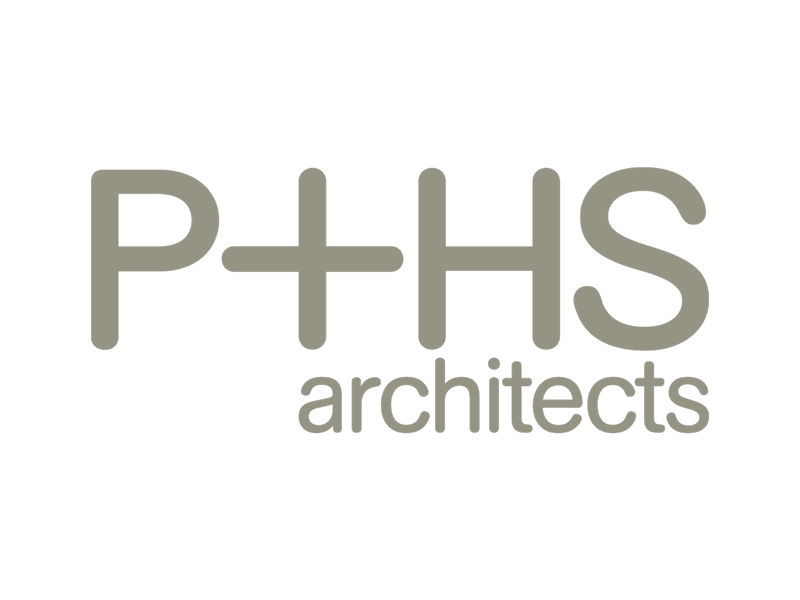As part of the 2015 Building Better Healthcare Awards, four gongs were handed out in the Patient Experience category, which recognises and celebrates projects and interventions, which have helped to enhance the health and social care environment for patients.
The winners were chosen from more than 50 entries across three categories, with the judges choosing two winners in the Award for Best Collaborative Arts Project category due to the strength of the nominations.
Prizes were presented by celebrity host, Gethin Jones, at a ceremony last week and recognised excellence in interior and exterior design and collaborative arts.
Here, we profile the winners of each of the awards.
Award for Best External Environment
Highly commended:
NHS Greater Glasgow and Clyde for Possilpark Health and Care Centre environmental project
The new Possilpark Health and Care Centre opened in February 2014 and comprises The Back Garden – a patient and community growing space; the Stoney Gym; and a streetscape, public realm and carpark area.
This environmental project marks an innovative use of urban space and makes a considerable contribution to the regeneration of the area.
The Back Garden element has transformed derelict and vacant land into a space for growing food and harnessing skills, as well as providing a natural play area and therapeutic space.
The garden has 25 individual, 10 organisational, and 11 communal plots, all of which are accessible. An onsite gardener promotes sustainability and community ownership by providing support to plotholders and he is also developing links with organisations supporting people with poor health and promoting social prescribing among local healthcare staff and GP practices.
The modular system, designed by ERZ, and installed by Landscape Engineering, can be assembled and dismantled easily and is made from waste timber supplied by Glasgow Wood Recycling, a community training agency.
Physical activity is really important for good health and wellbeing, and the Stoney Gym - a quirky outdoor gym that can give you a full body workout - is located to the side of the existing centre, leading patients, staff and members of the community to the Back Garden.
The addition of a green wall in the carpark, and tree planting on the street and around the centre, further helps to soften the urban setting.
The judges said: “This is very innovative use of land, supporting regeneration, the local community, and staff. They are clearly engaging a large number of people, offering opportunities for gardening and healthy activity through the external gym, as well as creating a community space.”
Winner:
The Landscape Partnership for Kingfisher Court (The Landscape Partnership, P+HS Architects)
Kingfisher Court is a £42m mental health facility in Radlett, Hertfordshire, which opened in June 2014. It has 86 bedrooms on five separate wards and specialists in acute adult mental healthcare, including adults with a learning disability or those who may be frail or vulnerable.
The landscape design creates a hierarchy of external spaces: from the secure active and passive courtyards associated with each ward; to the two large communal gardens within the confines of the unit, and the open external grounds beyond the secure perimeter.
The hierarchy of spaces is used throughout the therapeutic process, with access available to service users dependent upon their progress.
The ‘Active’ courtyards allow for active pursuits and social interaction, comprising a series of ‘outdoor rooms’ defined by low seating walls and different surfacing materials set within structural planting. The ‘rooms’ provide areas for kickabouts, table tennis or chess, enabling both service users and staff to interact.
The ‘Passive‘ courtyards comprise a quieter space with an informal circular pathway set with sensory planting for relaxation and meditative activities. A variety of seating allows for one-to-one and group therapeutic sessions. The pathway, defined by coloured tarmacadam, has distinctive sculptural indicators to provide triggers along the route. Realistic artificial grass has also been innovatively used to create a garden-style, but avoids the maintenance and safety implications of grass cutting.
The western Communal Garden allows for a range of horticultural therapeutic activities, with raised and flush growing areas and a polytunnel. Changes in level provide planted terraces and seating areas within an enclosed orchard area. The eastern communal garden provides open space for sports and fitness activities, including a grassed area for football, a surfaced basketball area, and outdoor gym equipment. A large labyrinth within the grass provides therapeutic opportunities.
Kingfisher Court is set within the estate of a former Victorian hospital and mature trees have been incorporated within the communal gardens and grounds. New parkland trees, wildflower meadows, meandering pathways, and occasional seats provide staff and service users with a peaceful sanctuary beyond the facility’s secure perimeter.
The terraced parkland landscape and low-lying timber-clad building were designed in harmony so the building merges with its woodland surroundings. Set within the Green Belt, improvements included connections with the wider public footpath network and enhanced biodiversity through woodland planting and the creation of a pond and wildflower meadows. Trained trees were used to create aerial hedges, reducing the extent of public views of the building, but allowing views out from the windows below the hedges.
The café courtyard with colourful planting and sculptural elements provides an informal meeting space for staff, visitors and service users.
Sustainable drainage techniques including a swale were incorporated into the design, providing biodiversity and drainage functions as well as a landscape frontage. Low-water plants including lavender were used to reduce the need for irrigation and timber from trees felled on site was used to create artworks.
The judges said: “A wide variety of different external areas have been created, offering quiet spaces as well as areas for socialisation and active engagement.
“Service users and staff were involved in the design and many features have been incorporated for therapeutic activities to support individual care plans.
“The external surroundings of the building have also been considered in the design.”
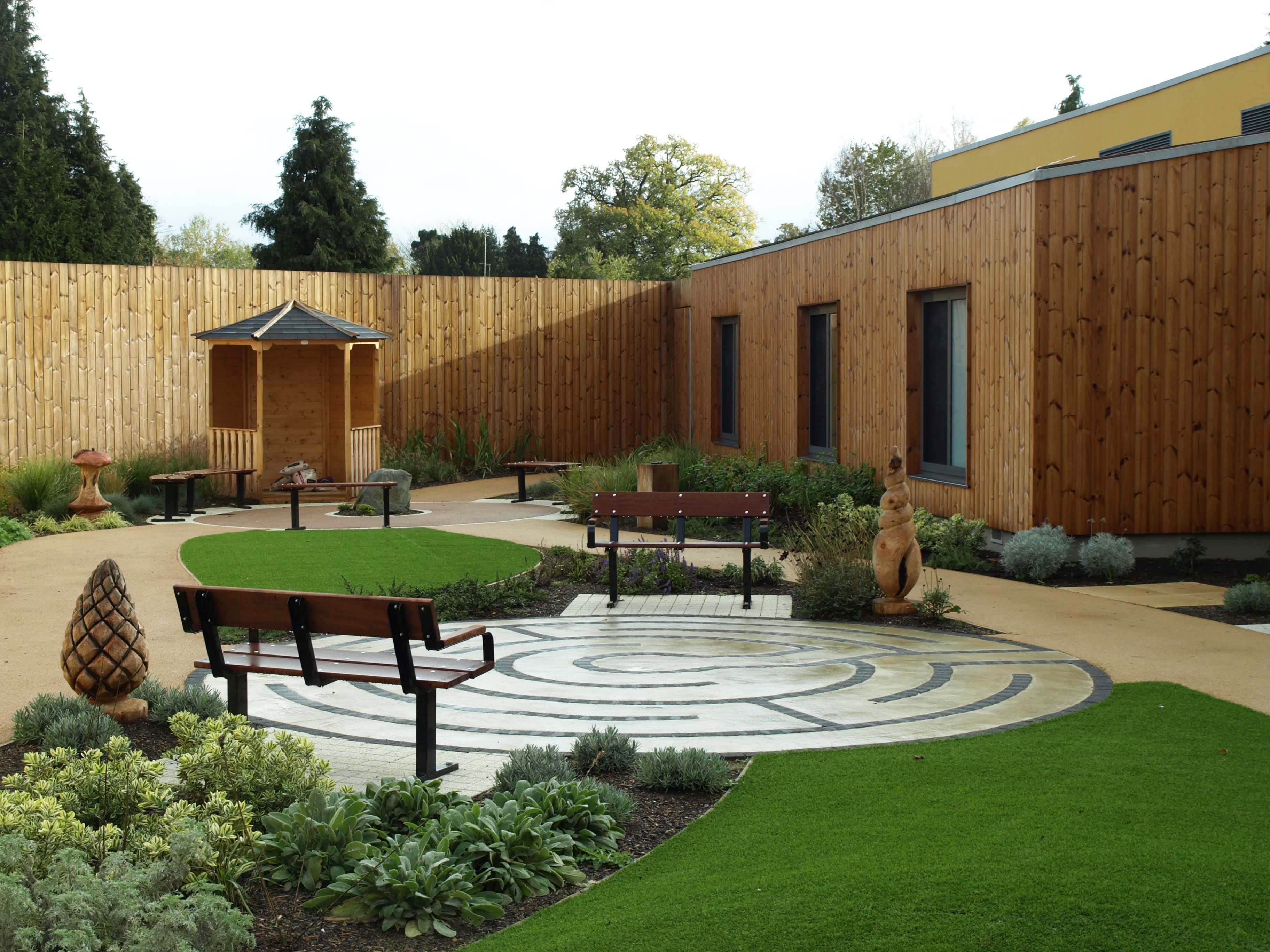
Kingfisher Court won the Award for Best External Environment
Award for Best Internal Environment
Highly commended:
Sonnemann Toon Architects for the Paediatric Outpatients Clinic, Harley Street
The Paediatric Outpatients Clinic at 84 Harley Street is a private healthcare facility.
The building was extensively refurbished and remodelled to provide a centralised paediatric facility to enhance the patient experience and improve staff workflows.
Care was taken to create the best facility within the existing envelope, seeking to employ a sophisticated palette to include features for children and parents alike.
Dignity is considered in every respect, from the consultation and examination rooms to the assessment bays using room layout and screens.
By joining spaces a more-open-plan main reception was achieved, providing good workflows, maximising natural light into the room, and providing a play space that is easily over looked by parents and reception staff.
Colour coding of the furniture and signage on each floor was used as an orientation device. Features include an artwork wall in the corridor space to encourage children to take a walking journey along the South Bank; integrated artwork within the external courtyard; and a fun selection of soft furnishings in the form of sweets, providing a welcome distraction to help alleviate anxiety.
Clare Sullivan, head of outpatient services at the Clinic, said: “The architects listened to our needs and have created a beautiful, functional environment for our patients.”
The judges added: “This has been beautifully done; there is no question about it. It is very good interior design that has preserved and enhanced the building.”
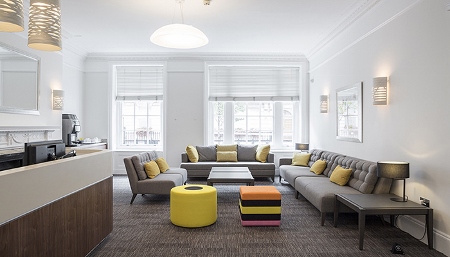
Sonnemann Toon Architects was highly commended in the Best Internal Environment category for the Paediatric Outpatients Clinic, Harley Street
Highly commended:
Willis Newson and Studio Weave for its ‘Terrell’ acoustic baffling sculpture at Bristol Royal Infirmary
Terrell is a new acoustic baffling sculpture designed by Studio Weave that is creating a pleasant and supportive environment for visitors, patients and staff at the Bristol Royal Infirmary (BRI).
The sculpture minimises noise and provides patient privacy within the acute medicine unit (AMU) on the ground floor of the new seven-storey atrium ward block.
Seen from the corridors at each level throughout the ward block, this striking-yet-functional artwork creates a visual centrepiece to the atrium and welcomes and inspires visitors as they catch glimpses of it on approach to the wards.
“The sculpture works on many levels. It’s a stunning piece of artwork that creates a visual focal point for the space, but it also solves a lot of practical problems that hospitals have to resolve,” said Deborah Lee, chief operating officer and deputy chief executive of the hospital.
An acoustic ceiling could have been created, but it would have blocked light and views. The sculpture creates an inspirational patient and working environment, while also solving all of the practical challenges of the space.
Suspended above the AMU, the sculpture is made from 270 acoustic-baffling panels and absorbs sound from the activity on the ground level, while providing additional privacy for patients by shielding sightlines from the upper floors.
It was inspired by the Terrell Rope Works, a family-run rope and twine business whose house used to sit on the hospital site.
Managed by arts and health consultants, Willis Newson, and funded by hospital’s charity, Above & Beyond, it is one of a number of arts projects creating a calming, uplifting and supportive environment for patients, their families and visitors, and staff within the redevelopment of the Bristol Royal Infirmary.
The judges said: “This is a replicable and innovative solution to provide both noise reduction and privacy.”
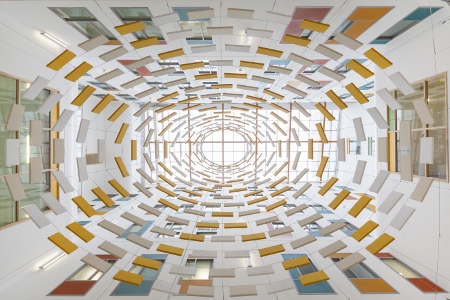
The Terrell acoustic-baffling sculpture at Bristol Royal Infirmary was also highly commended in this category
Winner:
IBI Group for the Sir Robert Ogden Macmillan Centre, Harrogate (IBI Group, Sir Robert McAlpine)
The Sir Robert Ogden Macmillan Centre is a new-build outpatient oncology centre which provides state-of-the-art consulting, treatment and patient support facilities, as well as a cancer information centre.
The design of the centre’s interiors responds to two principal drivers: Firstly; to deliver a functionally-effective facility through the achievement of appropriate clinical adjacencies and the fulfilment of relevant operational and technical requirements; and, secondly, to address the emotional needs of patients and their carers through the creation of a welcoming and spiritually-uplifting environment that also provides an inspirational and healthy workplace for staff.
The solution reflects a holistic approach to the integration of interior design, landscaping and art in order to create a tranquil, reassuring and non-institutional setting that more than satisfies these broad objectives.
The manipulation of space, volume and natural light, the selection of components, finishes and colours, and the integration of art into the building fabric and internal courtyards ensures that the physical and psychological needs of patients are met while maintaining appropriate privacy, dignity and confidentiality, and facilitating delivery of the highest standard of care.
The building takes the form of two asymmetric ‘pebbles’ – ‘non-institutional’ shapes that intrinsically avoid linear corridors and help to create a sense of identity for each of the centre’s principal functions.
The first ‘pebble’ accommodates consulting, examination, therapies and information facilities at ground-floor level, and administrative and staff rest facilities within a smaller staff-only first floor. The generous main waiting area, immediately visible from the main entrance, offers an opportunity for patients and carers to interact, share experiences and offer mutual support.
The relationship of the waiting area to surrounding clinical and treatment spaces is arranged to allow appropriately-discrete patient access and egress and so that adjacent facilities can be isolated to enable it to be used by support groups for out-of-hours meetings and other activities. The waiting area overlooks, and flows into, a healing garden designed to help calm those undergoing stressful experiences.
The second ‘pebble’, accessed via a glazed link, accommodates chemotherapy, minor procedures and ancillary facilities including a carers’ waiting area and beverage bay. Flooded with natural light, the large chemotherapy area is capable of flexible sub-division to cater for differing patient preferences and for interaction or solitude. It overlooks external landscaped areas on one side and the centre’s second internal garden on the other.
Given the susceptibility of chemotherapy patients to infection, high priority has been given to the specification of durable materials, components and detailing facilitating ease of cleaning and the control of infection including one of the UK’s-first deployments of inherently-anti-microbial copper alloy ‘touch’ door furniture.
Simon Henderson, head of cancer environments at Macmillan Cancer Support, said: “We know that good physical environments support personal wellbeing, contribute to positive treatment outcomes, and enable caring and effective staffing. “By listening to what patients and staff told us they wanted, we have turned the traditional treatment centre on its head and put their needs at the heart of this inspiring building.” The BBH Awards judges added: “This has been designed to enhance outcomes and there is expansive use of design to connect the inside and outside spaces.
“The building is welcoming, with lots of informal spaces to sit, and patient privacy, preferences and accessibility have informed the design throughout.”
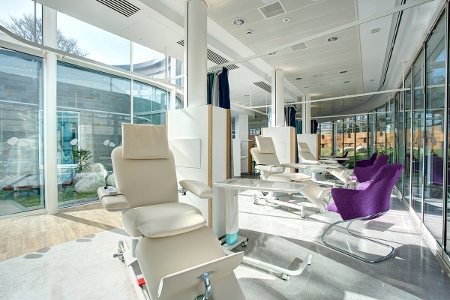
The Award for Best Internal Environment was won by IBI Group for the Sir Robert Ogden Macmillan Centre in Harrogate
Award for Best Collaborative Arts Project
Highly commended:
Willis Newson for its arts project at Southmead Hospital, Bristol
The Fresh Arts Festival was a three-day extravaganza held to celebrate the opening of Southmead Hospital Brunel building and to foster a sense of community within the hospital.
During the event 24 local artists, writers and musicians, and 11 local choirs delivered 277 performances, workshops and bedside activities to over 3,200 patients, visitors, staff and local residents.
North Bristol NHS Trust director of nursing, Sue Jones, said: “It was a fantastic three days - so inspiring. The festival brought a real sense of community to the hospital and was so beneficial for patients. It was like breathing soul into the building.
“We’ve designed the hospital to be a healing environment and the arts programme has made that personal for people.”
During the event choirs sang in patients’ rooms, orthopaedic doctors built model cars, and patients knitted and chatted with members of the public.
“Art can help patients to make progress,” said Jones. “We have to keep this going – to use the arts to keep the life and community in the hospital for the benefit of patients and staff.”
The event was organised by arts consultancy, Willis Newson, and is now being copied by other NHS trusts.
Praising the low cost of running the event – just £14,000 – the BBH Awards judges said: “It is an extraordinary achievement to organise 277 performances in just three days.
“There was an eclectic series of activities for everybody to celebrate creativity and wellbeing. It was fantastic value for money and others can learn from it.”
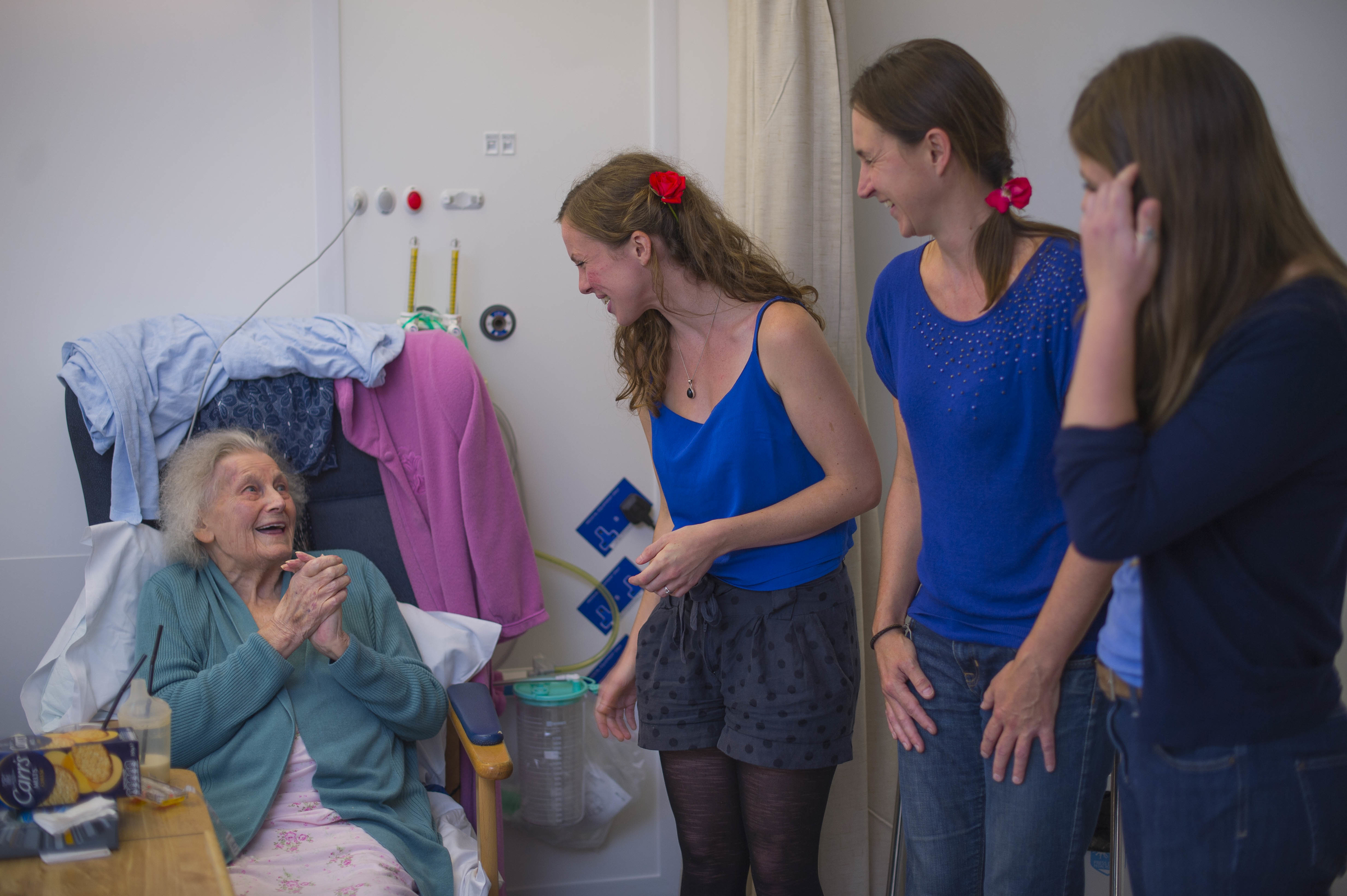
Willis Newson was highly commended for its three-day arts festival at Southmead Hospital, Bristol
Winner:
South West Yorkshire Partnership NHS Foundation Trust for its Creative Minds arts strategy (South West Yorkshire Partnership NHS Foundation Trust, Creative Minds)
Creative Minds is an award-winning strategy that develops community partnerships and co-funds creative projects across South West Yorkshire Partnership NHS Foundation Trust’s localities in Barnsley, Calderdale, Kirklees, Wakefield, and its forensic services.
It utilises creative activities such as arts, sports, recreation, and leisure, delivered in partnership with more than 70 local community organisations to increase the confidence, develop the social skills, and improve the lives of local people.
Creative Minds was launched in response to service users and carers expressing their desire for more-creative approaches to understanding and supporting their health and wellbeing. The strategy was co-produced through a series of workshops focusing on working with, and listening to, the views of service users, carers, trust staff and community organisations and groups.
The approach recognises that successful interventions that have an impact on mental health conditions through timely, targeted support will have substantial social and cost benefits. It brings key partners together from across the sectors to understand how their actions can impact on health and wellbeing and how, by working collaboratively and adopting models of good practice, they can play an important role in maintaining and improving health and wellbeing.
The project has been extremely successful building the recognition of the trust as a leading organisation which uses creative approaches to improve health and wellbeing.
Phil Walters of South West Yorkshire Partnership NHS Foundation Trust said: “We have initiated a genuine social movement of which people want to be a part and for which people feel a sense of ownership.
“A key component of the popularity of Creative Minds is the fact that it holds such a broad definition of ‘creativity’. Arts, sports, recreation, and leisure activities are just some of the types of projects that Creative Minds co-funds, giving participants the opportunity to take control of their own care and recovery through feeling empowered to make their own choices. This is just one of the reasons why 4,000 people have been able to benefit from the initiative.
“Many participants find that they discover a passion for a particular activity or talent they never knew they had, which gives them the means to maintain their health and wellbeing through finding a hobby they can continue to enjoy for the rest of their lives.”
Participating creatively as a means of self-expression tackles social exclusion, promotes self-acceptance ,and raises aspirations, allowing the individual to discover talents, skills and abilities that combat the feelings of negativity surrounding their mental health.
“Where individuals have low expectations and poor self image, the sense of achievement found in creativity gives them a chance to move away from negative and self-destructive patterns and habits, and start to write a new story of recovery,” said Walters.
Choosing it as their joint winner, the BBH Awards judges added: “This is an extraordinary programme of creative arts and engagement, with something for the whole community.
“They have taken a very broad approach linking health and wellbeing in a very positive way. This is a clearly successful intuitive that has been well evaluated.”
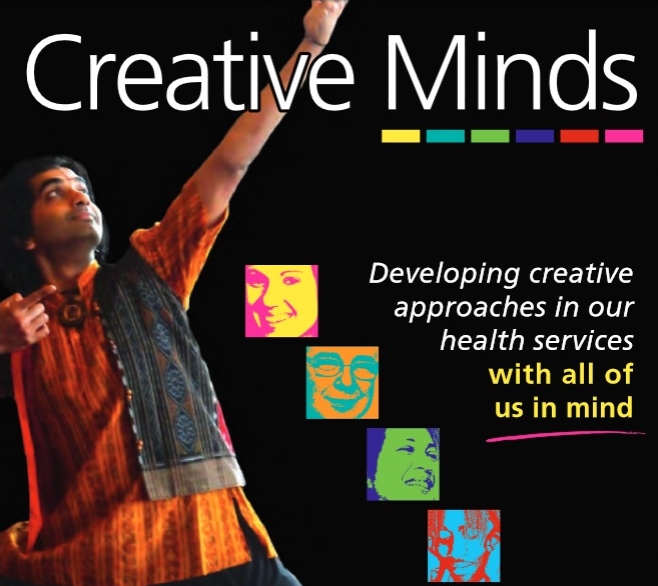
South West Yorkshire Partnership NHS Foundation Trust was joint winner of the Award for Best Collaborative Arts Project for its Creative Minds arts strategy
Winner:
Stride Treglown for its Progress Through Play project at Singleton Hospital, Swansea
Hafan y Mor - or Haven of the Sea - is a most-apt name for the new Children’s Development Centre at Singleton Hospital Swansea.
The facility provides a safe and secure environment for child health services, providing therapeutic care and ongoing assessment for children aged from six months to 19 years with a wide range of disabilities and life issues.
The artwork for the new centre is the outcome of a therapeutic consultation process involving the children and families who will use the centre and the wider community. Through this collaboration, the theme of sun, sea and sand emerged.
Local environmental artists and families gathered on the beach to explore and create. Children were given their own cameras to record their day, and the resulting artwork is fully integrated into the patient environment.
Photographs from that day have been turned into floor-to-ceiling wall graphics in the waiting areas, which lack natural light; while ‘sky’ ceiling lit panels bring the outside in and doors have a beach hut surround.
Fish silhouettes in each consulting room offer a calming distraction and large-scale sailing boats mark the disabled car parking bays. Blackboard cupboard doors invite children to make their mark.
The team wanted to enliven the imposing wall overlooking the proposed sensory playground with kites, which are a familiar summer sight on Swansea beach, so a county-wide call went out for children to create designs. The response was overwhelming, with 600 entries. The final 55 were chosen from 22 schools, including a special needs school. A local Brownie Pack, Cub troop, and community youth group were also involved.
The Swansea Children’s Therapy Centre Support Group raised funds to provide an all-ability playground with sensory equipment and plants.
In order to get the most out of the funding, and for the centre to benefit from as much specialist equipment as possible, the team had to be innovative to maximise the art vision and were led by the in-house arts co-ordinator.
Jessica Ellis of Stride Treglown said: “It is true to say that all contributed towards the design, development, look, and feel of the centre.
“The overwhelmingly-positive reception for the completed scheme has been extremely rewarding for all participants and is evidence for other project teams that collaboration with diverse groups has a high value in investment and ownership.”
The judges added: “This is a beautiful project and it involved the children and their families in creating the very-evocative photographs and artworks, as well as having some fun in the process. It shows great collaboration with the contractors and local groups, as well as children throughout the county.”
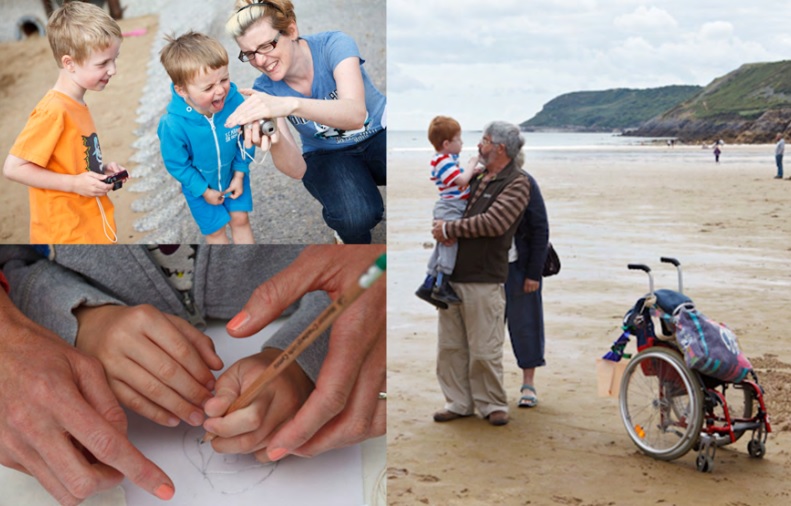
Stride Treglown was also named winner for its Progress Through Play project at Singleton Hospital, Swansea
To find out who won other awards at the ceremony, click here.




